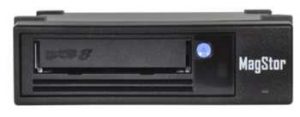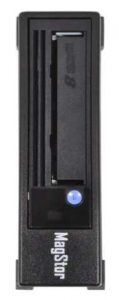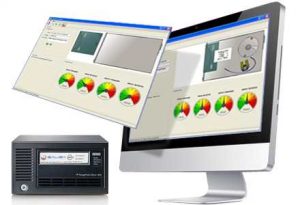Use LTO-8 Drive on Horizontal, Not Vertical Orientation Altering by 3X Writing Performance
Calculated "Mr. Tape Cartrige" George Saliba
This is a Press Release edited by StorageNewsletter.com on February 24, 2021 at 2:30 pmBy George Saliba, president and CEO, Saliba Technologies, Inc.
Abstract: The topic of the preferred mounting orientation of tape drives has been discussed for decades, clearly the drive mounting orientation will alter the head mass effect on the servo loop performance when the head is suspended by the actuator or resting on the guides.
MagStor LTO-8 HH SAS 8088 external desktop tape drive 12TB front and rear
Over the years, number of tests were conducted on various DLT drives and even decades ago, the data showed a preferred drive mounting orientation can influence drive performance. Considering that quick review of the LTO-8 shows the similar drive architecture to DLT, the question has remained unanswered if the drive mounting orientation can affect the drive performance. This study was recently requested by MagStor, Inc. to quantify the effect of the mounting orientation on the LTO-8 drive performance. The tests were conducted on a IBM LTO-8 IBM tape drive supplied by Magstor (Magstor PN SAS-HL8-8088), the standard Tape drive Doctor advanced test routines was used to conduct the tests.
The topic of the preferred mounting orientation of tape drives has been discussed for decades, clearly the drive mounting orientation will alter the drive head mass effect on the servo loop performance when the head is suspended by the actuator or resting on the guides. Also the drive mounting orientation could affect the dynamics of the tape lateral tape motion as it spools onto the reels and even the head to tape interface could affect the sensitive R/W performance. Due to the complexity of the system interaction, the first order of this analysis was to design a simulated customer test to determine if we can detect any orientation effects. Over the years, number of tests were conducted on various DLT drives and even decades ago, the test data showed a preferred drive mounting orientation, considering the LTO-8 has similar drive architecture to DLT, the question regarding the effect of tape drive mounting orientation on the drive performance of LTO drives has remained largely unanswered.
Tape Drive Doctor tool
Few words about Tape Drive Doctor tool (TDD). It was originally developed and patented by Quantum Corporation and later advanced by Saliba Technologies Corporation. The objective of this tool is to test LTO drives performance during simulate customer R/W operations and cartridge R/W interchange using calibrated cartridges. This tools has been used extensively by drive repair companies and information regarding the technology and patents.
TDD basic routine consist of reading and writing customer data at specific tape locations, by measuring the time of various operations, a figure of merit of the drive performance is reported. It also interrogate the drive error rates and servo defects so at the end of the test, we have a full 360° results representing tape drive performance. All TDD test cartridges are calibrated to a gold standard, and the results are purely the drive performance.
The quality value is linearized and normalize. The value of 3, represent the center line drive, a lower value is better than average and higher value represent a worse than average drive. For complete picture, we will report the raw data reported by the drive, the actual process time and normalize performance.
For the test, a IBM LTO-8 drive serial number YY1097006353 supplied by MagStor was used. The 2 orientations tested were according to the instruction of the drive manufacture, first the horizontal direction 2 passes. Second, 2 passes in the vertical direction. Special attention was taken to insulate the drive from any possible outside vibration to purely measure the effect of the mountain orientation.
First set of tests, drive mounted in horizontal direction
MagStor Horizontal orientation

Below are the timing data as reported by TDD test portion of writing 5,000 blocks repeated 8 cycles when the drive mounted in the horizontal direction.
LTO-8 first test horizontal reverse direction
-
01/18/2021 15.38.53.328 Wr Rev Process Time Cycle 1 in Milliseconds
-
01/18/2021 15.38.53.375 2 2 2 2 2 2 2 2
-
01/18/2021 15.38.53.406 gCPW_TimeRev Normalized
-
01/18/2021 15.38.53.468 3.022 3.000 3.000 3.000 3.000 3.000 3.000 3.000
LTO-8 second test horizontal reverse direction
-
01/18/2021 16.42.56.859 2 2 2 2 2 2 2 2
-
01/18/2021 16.42.56.890 gCPW_TimeRev Normalized
-
01/18/2021 16.42.56.953 3.000 3.000 3.000 3.000 3.000 3.000 3.000 3.000
LTO-8 first test horizontal forward direction
-
01/18/2021 15.40.28.796 2 2 2 2 2 2 2 2
-
01/18/2021 15.40.28.828 gCPW_TimeFwd Normalized
-
01/18/2021 15.40.28.890 3.000 3.000 3.000 3.000 3.000 3.000 3.000 3.000
LTO-8 second test horizontal forward direction
-
01/18/2021 16.44.32.375 2 2 2 2 2 2 2 2
-
01/18/2021 16.44.32.406 gCPW_TimeFwd Normalized
-
01/18/2021 16.44.32.468 3.000 3.000 3.000 3.000 3.000 3.000 3.000 3.000
Second set of tests, drive mounted in vertical direction
Below are the timing data as reported by TDD test portion of writing 5,000 blocks repeated 8 cycles when the drive mounted in the vertical direction.
MagStor vertical orientation

LTO-8 first test vertical writing in reverse direction
-
01/18/2021 15.51.41.500 8 3 2 2 2 2 2 2
-
01/18/2021 15.51.41.531 gCPW_TimeRev Normalized
-
01/18/2021 15.51.41.609 12.176 4.773 3.000 3.000 3.000 3.000 3.000 3.000
LTO-8 second test vertical writing in reverse direction
-
01/18/2021 16.09.25.796 7 2 2 2 2 2 2 2
-
01/18/2021 16.09.25.812 gCPW_TimeRev Normalized
-
01/18/2021 16.09.25.875 11.140 3.000 3.000 3.000 3.000 3.000
-
3.000 3.000
LTO-8 first test vertical writing in forward direction
-
01/18/2021 15.53.39.531 2 2 2 2 2 2 2 2
-
01/18/2021 15.53.39.578 gCPW_TimeFwd Normalized
-
01/18/2021 15.53.39.656 3.055 3.000 3.000 3.000 3.000 3.000
-
3.000 3.000
LTO-8 second test vertical writing in forward direction
-
01/18/2021 16.21.44.125 2 2 2 2 2 2 2 2
-
01/18/2021 16.21.44.171 gCPW_TimeFwd Normalized
-
01/18/2021 16.21.44.234 3.000 3.000 3.000 3.000 3.000 3.000
-
3.000 3.000
Horizontal, first pass LTO-8 servo data
-
01/18/2021 15.39.52.031 Servo stop write Fwd : 0
-
01/18/2021 15.39.52.046 Servo stop write Rev : 0
-
01/18/2021 15.39.52.062 Write skip Fwd : 363
-
01/18/2021 15.39.52.078 Write skip Rev : 1966
Horizontals, second pass LTO-8 servo data
-
01/18/2021 16.21.07.437 Servo stop write Fwd : 0
-
01/18/2021 16.21.07.453 Servo stop write Rev : 15
-
01/18/2021 16.21.07.468 Write skip Fwd : 370
-
01/18/2021 16.21.07.484 Write skip Rev : 1964
Vertical, first pass LTO-8 servo data
-
01/18/2021 15.53.02.812 Servo stop write Fwd : 0
-
01/18/2021 15.53.02.828 Servo stop write Rev : 152
-
01/18/2021 15.53.02.859 Write skip Fwd : 427
-
01/18/2021 15.53.02.875 Write skip Rev : 2363
Vertical, second pass LTO-8 servo data
-
01/18/2021 16.10.41.390 Servo stop write Fwd : 0
-
01/18/2021 16.10.41.406 Servo stop write Rev : 167
-
01/18/2021 16.10.41.421 Write skip Fwd : 404
Tape drive doctor detected significant 300% slower timing write performance degradation in the reverse direction when the drive was mounted in the vertical direction as opposed to the horizontal direction. Upon further analysis of the dive raw data, the cause was determined to be the servo loop optimization.
-
01/18/2021 16.10.41.421 Write skip Rev : 2377
Conclusion: Based on the data from testing the IBM LTO-8 drive, when the drive is mounted in the vertical direction, the drive delivered worse performance than in the horizontal position. In this calibrated test, LTO TDD, during repeated tests, measured as much as 3x slower performance when the drive was mounted in the vertical direction as compared the horizontal direction. Furthermore, the drive reported an order of magnitude increase in write servo skips in this drive. Large servo skip count indicates the potential for large losses of cartridge capacity that will reduce the total usable capacity of the LTO-8 drive. Based on this test, we recommend mounting IBM LTO-8 drives in the horizontal direction.
About author:
George Saliba is the president and CEO, Saliba Technologies, Inc. located in Boulder, CO. For the past 8 years at the company, he invented and led the development of multiple advanced storage products including the successful TDD for LTO and DLT tapes, and the Global Storage Solution technology
During his tenure at Saliba Technologies, he continues to provide technology & IP consulting to multiple Fortune 500 companies in the field of disk, tape and storage systems. Prior to Saliba Technologies, he was responsible for the development of the successful DLT and SDLT families of tape and automation data storage products at Quantum Corporation. He was the primary inventor of the DLT and SDLT tape product line and was instrumental in the growth of the DLT and SDLT tape. He is credited for inventing multiple tape technology advances and completing, ahead of the competition, 8 consecutive leadership DLT and SDLT tape products (DLT260, DLT2000, DLT4000, DLT7000, DLT8000, SDLT1 and SDLT2). DLT became the standard for tape storage products, shipping over 100 million tape cartridges. Saliba also was responsible for the development of all the DLTtape media and DLTStor Tape Automation.
The success of these products has resulted in the growth of Quantum’s business from $200 million to over $1 billion. Saliba is known in the industry as ‘Mr. DLT’. His career spans over 35 years in the storage industry.
Prior to Quantum, he was the senior group engineering manager for TK70, TF70, and for the tapes of all DLT tape storage products developed at Digital Equipment Corporation. He also held a variety of senior engineering management and technical staff positions in developing disk drives at Storage Technology Corporation from 1977–1986. He has received numerous awards for his work. In 1996, he was voted Quantum’s Inventor of the Year.
For his many DLT inventions and innovations, in 1997, he was awarded Quantum’s Lifetime Achievement Award. He has also received, for the second time, the Inventor of the Year Award in 1998. He recently received the 2016 Distinguished Alumni Award from the University of
Colorado, Denver.
He has over 90 issued patents covering various data storage technologies. He has published extensively in the magnetic recording field. He earned BSEE and MSEE degrees from the University of Colorado, and holds BT1 and BT2 degrees in Electrical Engineering from Ecole des Arts et Sciences.
















 Subscribe to our free daily newsletter
Subscribe to our free daily newsletter

